2020-2021学年外研版(2019)选择性必修三教案:Unit1 Face values(全单元)
文档属性
| 名称 | 2020-2021学年外研版(2019)选择性必修三教案:Unit1 Face values(全单元) | 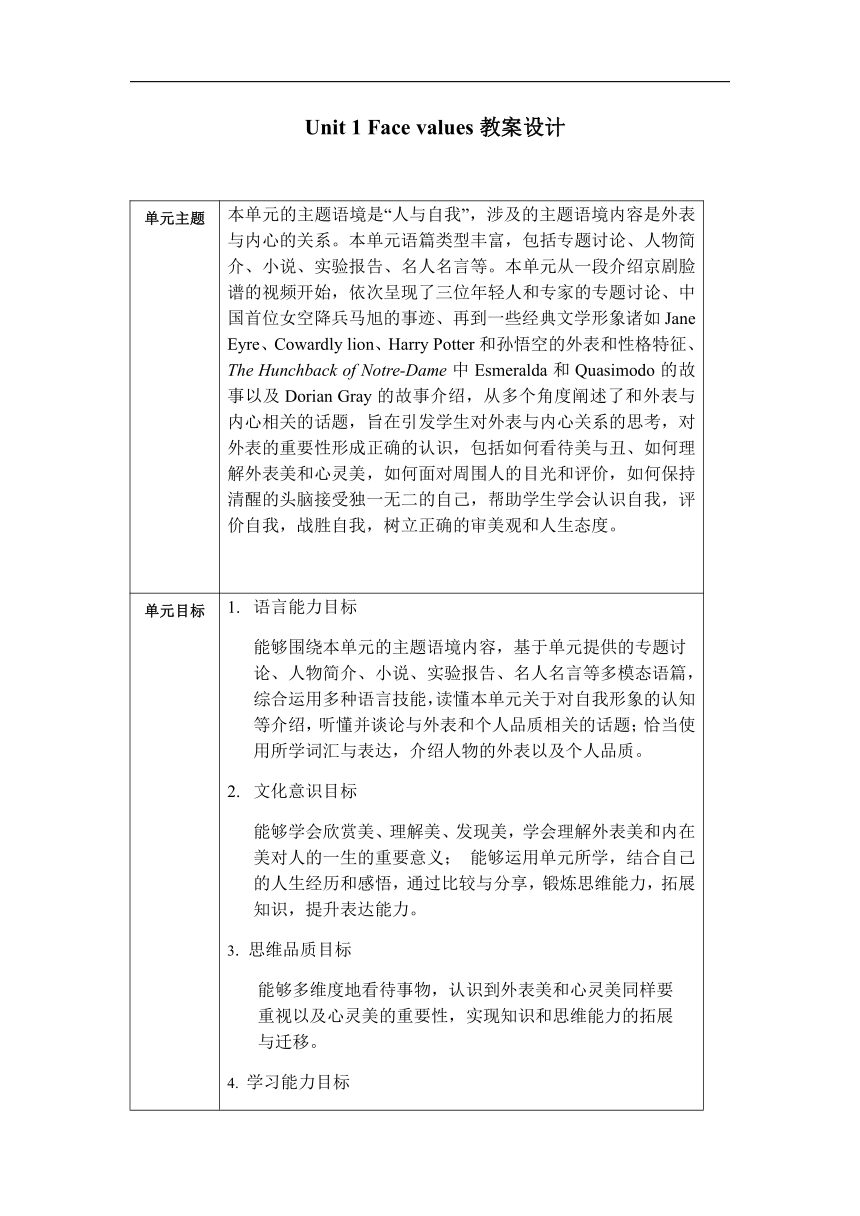 | |
| 格式 | docx | ||
| 文件大小 | 44.2KB | ||
| 资源类型 | 教案 | ||
| 版本资源 | 外研版(2019) | ||
| 科目 | 英语 | ||
| 更新时间 | 2021-01-15 22:05:52 | ||
图片预览

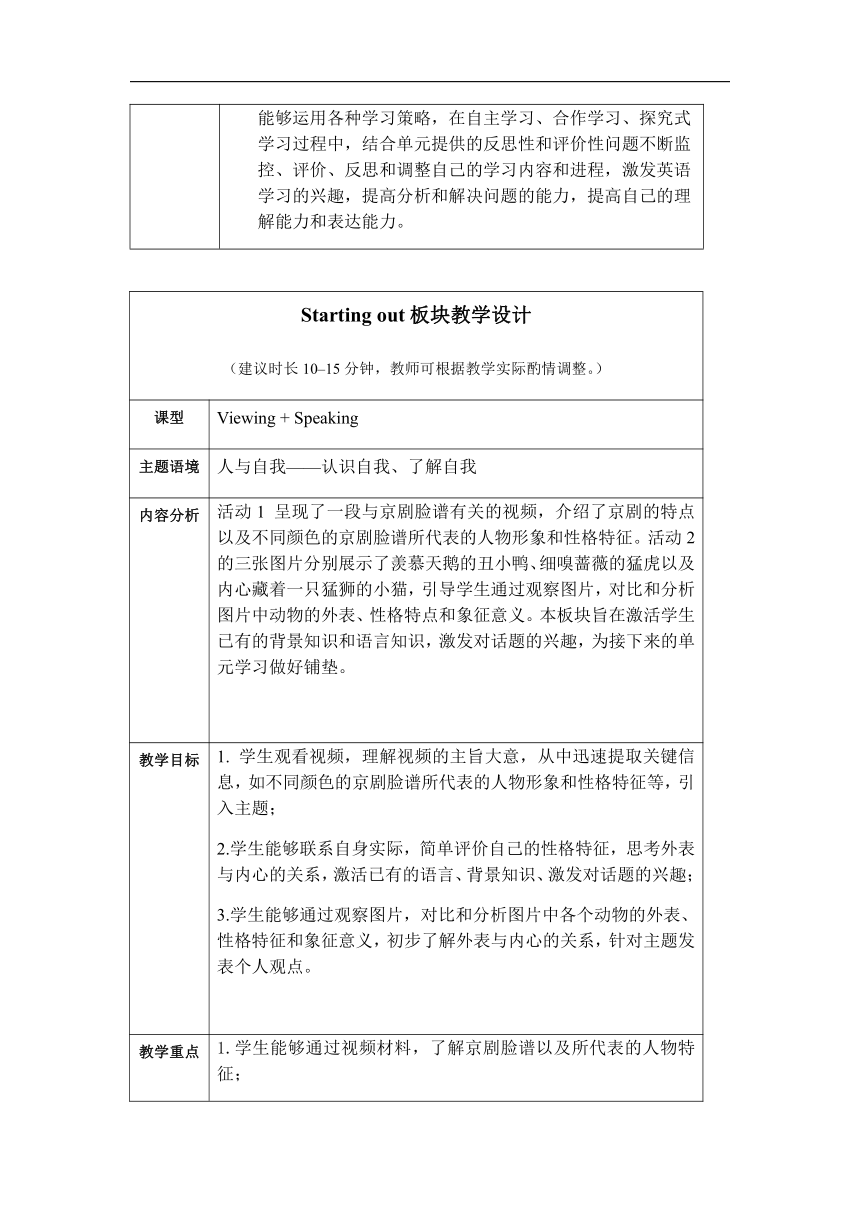
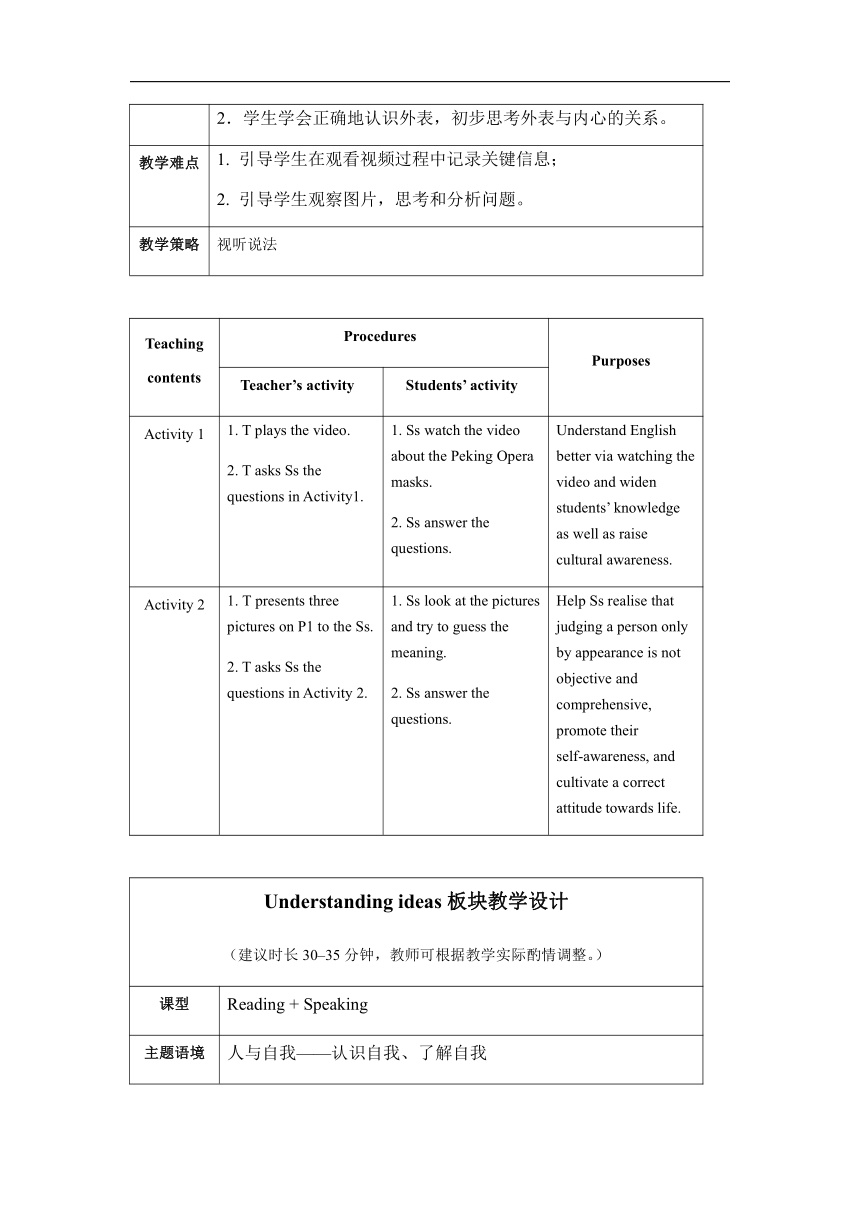
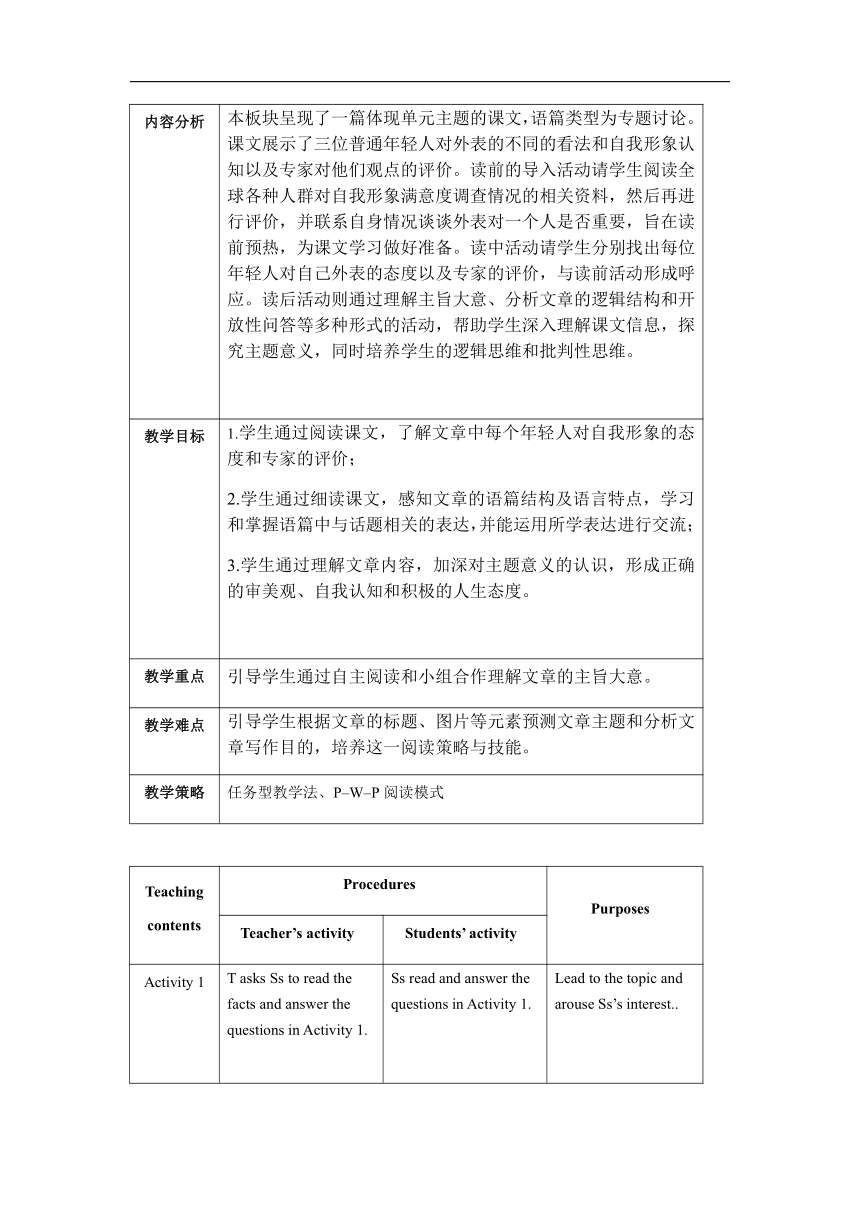
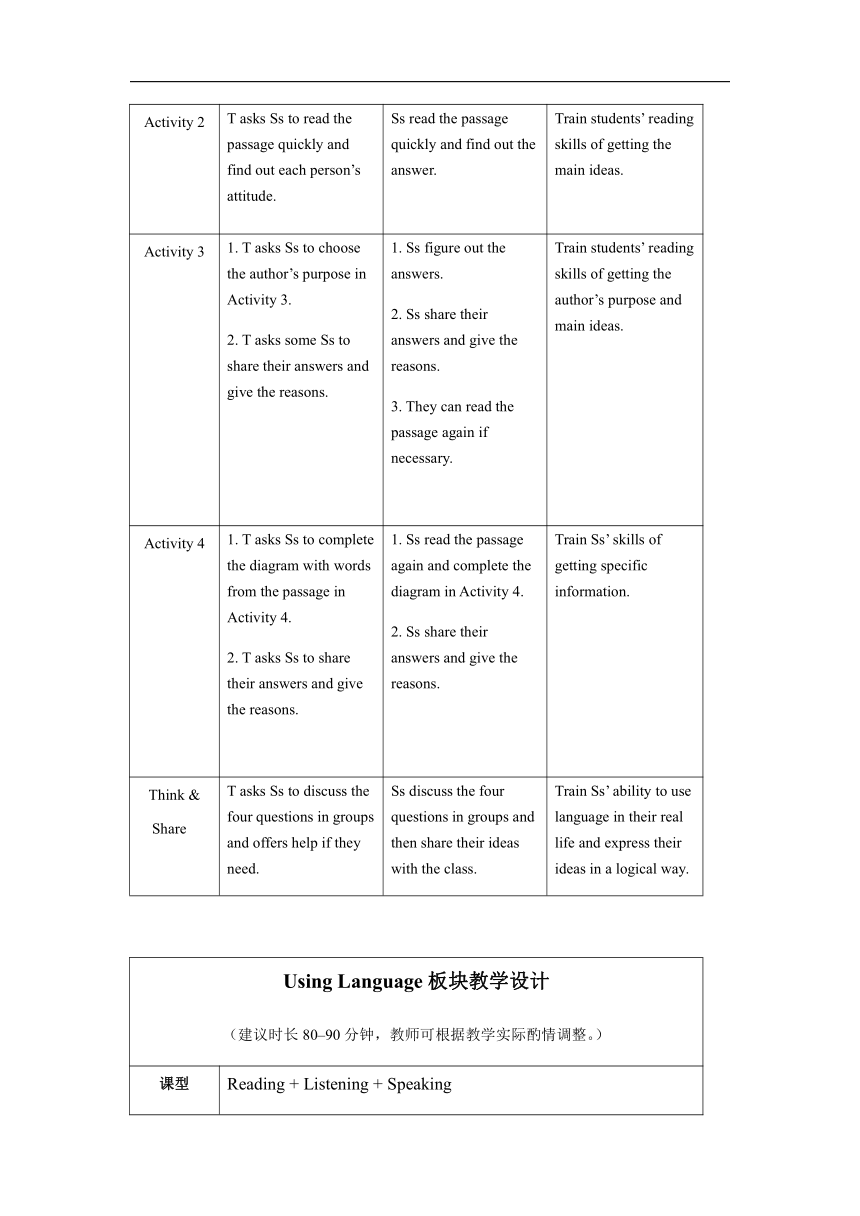
文档简介
Unit 1 Face values教案设计
单元主题
本单元的主题语境是“人与自我”,涉及的主题语境内容是外表与内心的关系。本单元语篇类型丰富,包括专题讨论、人物简介、小说、实验报告、名人名言等。本单元从一段介绍京剧脸谱的视频开始,依次呈现了三位年轻人和专家的专题讨论、中国首位女空降兵马旭的事迹、再到一些经典文学形象诸如Jane Eyre、Cowardly lion、Harry Potter和孙悟空的外表和性格特征、The Hunchback of Notre-Dame中Esmeralda和Quasimodo的故事以及Dorian Gray的故事介绍,从多个角度阐述了和外表与内心相关的话题,旨在引发学生对外表与内心关系的思考,对外表的重要性形成正确的认识,包括如何看待美与丑、如何理解外表美和心灵美,如何面对周围人的目光和评价,如何保持清醒的头脑接受独一无二的自己,帮助学生学会认识自我,评价自我,战胜自我,树立正确的审美观和人生态度。
单元目标
语言能力目标
能够围绕本单元的主题语境内容,基于单元提供的专题讨论、人物简介、小说、实验报告、名人名言等多模态语篇,综合运用多种语言技能,读懂本单元关于对自我形象的认知等介绍,听懂并谈论与外表和个人品质相关的话题;恰当使用所学词汇与表达,介绍人物的外表以及个人品质。
文化意识目标
能够学会欣赏美、理解美、发现美,学会理解外表美和内在美对人的一生的重要意义; 能够运用单元所学,结合自己的人生经历和感悟,通过比较与分享,锻炼思维能力,拓展知识,提升表达能力。
3. 思维品质目标
能够多维度地看待事物,认识到外表美和心灵美同样要重视以及心灵美的重要性,实现知识和思维能力的拓展与迁移。
4. 学习能力目标
能够运用各种学习策略,在自主学习、合作学习、探究式学习过程中,结合单元提供的反思性和评价性问题不断监控、评价、反思和调整自己的学习内容和进程,激发英语学习的兴趣,提高分析和解决问题的能力,提高自己的理解能力和表达能力。
Starting out板块教学设计
(建议时长10–15分钟,教师可根据教学实际酌情调整。)
课型
Viewing + Speaking
主题语境
人与自我——认识自我、了解自我
内容分析
活动1 呈现了一段与京剧脸谱有关的视频,介绍了京剧的特点以及不同颜色的京剧脸谱所代表的人物形象和性格特征。活动2 的三张图片分别展示了羡慕天鹅的丑小鸭、细嗅蔷薇的猛虎以及内心藏着一只猛狮的小猫,引导学生通过观察图片,对比和分析图片中动物的外表、性格特点和象征意义。本板块旨在激活学生已有的背景知识和语言知识,激发对话题的兴趣,为接下来的单元学习做好铺垫。
教学目标
1. 学生观看视频,理解视频的主旨大意,从中迅速提取关键信息,如不同颜色的京剧脸谱所代表的人物形象和性格特征等,引入主题;
2.学生能够联系自身实际,简单评价自己的性格特征,思考外表与内心的关系,激活已有的语言、背景知识、激发对话题的兴趣;
3.学生能够通过观察图片,对比和分析图片中各个动物的外表、性格特征和象征意义,初步了解外表与内心的关系,针对主题发表个人观点。
教学重点
1.学生能够通过视频材料,了解京剧脸谱以及所代表的人物特征;
2.学生学会正确地认识外表,初步思考外表与内心的关系。
教学难点
1. 引导学生在观看视频过程中记录关键信息;
2. 引导学生观察图片,思考和分析问题。
教学策略
视听说法
Teaching contents
Procedures
Purposes
Teacher’s activity
Students’ activity
Activity 1
1. T plays the video.
2. T asks Ss the questions in Activity1.
1. Ss watch the video about the Peking Opera masks.
2. Ss answer the questions.
Understand English better via watching the video and widen students’ knowledge as well as raise cultural awareness.
Activity 2
1. T presents three pictures on P1 to the Ss.
2. T asks Ss the questions in Activity 2.
1. Ss look at the pictures and try to guess the meaning.
2. Ss answer the questions.
Help Ss realise that judging a person only by appearance is not objective and comprehensive, promote their self-awareness, and cultivate a correct attitude towards life.
Understanding ideas板块教学设计
(建议时长30–35分钟,教师可根据教学实际酌情调整。)
课型
Reading + Speaking
主题语境
人与自我——认识自我、了解自我
内容分析
本板块呈现了一篇体现单元主题的课文,语篇类型为专题讨论。课文展示了三位普通年轻人对外表的不同的看法和自我形象认知以及专家对他们观点的评价。读前的导入活动请学生阅读全球各种人群对自我形象满意度调查情况的相关资料,然后再进行评价,并联系自身情况谈谈外表对一个人是否重要,旨在读前预热,为课文学习做好准备。读中活动请学生分别找出每位年轻人对自己外表的态度以及专家的评价,与读前活动形成呼应。读后活动则通过理解主旨大意、分析文章的逻辑结构和开放性问答等多种形式的活动,帮助学生深入理解课文信息,探究主题意义,同时培养学生的逻辑思维和批判性思维。
教学目标
1.学生通过阅读课文,了解文章中每个年轻人对自我形象的态度和专家的评价;
2.学生通过细读课文,感知文章的语篇结构及语言特点,学习和掌握语篇中与话题相关的表达,并能运用所学表达进行交流;
3.学生通过理解文章内容,加深对主题意义的认识,形成正确的审美观、自我认知和积极的人生态度。
教学重点
引导学生通过自主阅读和小组合作理解文章的主旨大意。
教学难点
引导学生根据文章的标题、图片等元素预测文章主题和分析文章写作目的,培养这一阅读策略与技能。
教学策略
任务型教学法、P–W–P阅读模式
Teaching contents
Procedures
Purposes
Teacher’s activity
Students’ activity
Activity 1
T asks Ss to read the facts and answer the questions in Activity 1.
Ss read and answer the questions in Activity 1.
Lead to the topic and arouse Ss’s interest..
Activity 2
T asks Ss to read the passage quickly and find out each person’s attitude.
Ss read the passage quickly and find out the answer.
Train students’ reading skills of getting the main ideas.
Activity 3
1. T asks Ss to choose the author’s purpose in Activity 3.
2. T asks some Ss to share their answers and give the reasons.
1. Ss figure out the answers.
2. Ss share their answers and give the reasons.
3. They can read the passage again if necessary.
Train students’ reading skills of getting the author’s purpose and main ideas.
Activity 4
1. T asks Ss to complete the diagram with words from the passage in Activity 4.
2. T asks Ss to share their answers and give the reasons.
1. Ss read the passage again and complete the diagram in Activity 4.
2. Ss share their answers and give the reasons.
Train Ss’ skills of getting specific information.
Think & Share
T asks Ss to discuss the four questions in groups and offers help if they need.
Ss discuss the four questions in groups and then share their ideas with the class.
Train Ss’ ability to use language in their real life and express their ideas in a logical way.
Using Language板块教学设计
(建议时长80–90分钟,教师可根据教学实际酌情调整。)
课型
Reading + Listening + Speaking
主题语境
人与自我——认识自我、了解自我
内容分析
本板块的语法部分的主要内容是主语从句。第一个小语段介绍了喜剧演员外表呈现的并不一定是内心真正的情绪。第二个小语段落讲述了中国首位女空降兵马旭的事迹。听说部分介绍了一个著名的心理学实验。词汇部分通过分析几个经典的文学形象呈现与外表和性格相关的词汇。本板块帮助学生深度聚焦语言的意义和功能,通过真实语境下技能的综合训练,加深对单元主题的理解,提高综合语言运用能力。
教学目标
1.学生能够通过了解主语从句的结构和表意功能,掌握主语从句的用法,并能够在真实语境中对其进行运用;
2.学生初步掌握并能够恰当地使用描述人物外表和性格的词语,讨论人物的外表和性格;
3.学生能够关注语用功能,学会运用所学表达进行演讲,并能够在实际生活中应用;
4.学生初步认识外表的重要性,树立积极的人生态度。
教学重点
引导学生去发现并总结主语从句的特点和使用规则。
教学难点
引导学生关注英语句子结构。熟悉并能分析句子结构是了解英语语言特点的基础。
教学策略
交际教学法、任务型教学法
Teaching contents
Procedures
Purposes
Teacher’s activity
Students’ activity
Activity 1
1. T asks Ss to read the sentences in Activity 1 and answer the questions.
2. T helps Ss find out some features of subject clauses.
3. T asks Ss to find out the differences between a / c and b / d.
4. T asks Ss to look for more examples of each type in the reading passage.
1. Ss look at the sentences and answer the questions.
2. Ss finish Activity 1 on P5.
Study different conjunctions in subject clauses.
Activity 2
T gives the task in Activity 2 and offers help.
1. Ss read the passage and understand the main ideas.
2. Ss choose the correct words.
Deepen Ss’s understanding of subject clauses.
Activity 3
T asks Ss to read the profile of Ma Xu on P5 and write an introduction to her, using subject clauses.
Ss read the profile on P5 and write an introduction to Ma Xu, using subject clauses.
Learn how to write a short biography and put subject clauses into practical use.
Activity 4
T asks Ss to do the task in Activity 4.
Ss finish the task in Activity 4 on P5.
Put what Ss have learnt into practice.
Activity 5
1. T plays the recording.
2. T asks Ss to choose the title.
1. Ss listen for the first time to get the main ideas.
2. Ss choose the title.
Train the listening skills of getting the main ideas in a quick way.
Activity 6
1.T plays the recording again and asks Ss to complete the fact sheet.
2. T asks Ss to share their answers.
3. T plays the recording again and asks Ss to make notes of key words.
4. T divides Ss into groups and asks Ss to give a short introduction to the experiment.
1. Ss listen to the recording and complete the sheet.
2. Ss share their answers.
3. Ss listen to the recording and make notes.
4. Ss give a short introduction to their group members and then to the whole class.
Learn how to get specific information in a listening passage.
Train the Ss’ speaking and summarising skills.
Activity7
1. T asks Ss to complete the boxes with the expressions from the recording.
2. T asks Ss to work in pairs and act out the presentation.
3. T invites some students to perform to the class.
1. Ss complete the boxes with the expressions from the recording.
2. Ss work in pairs and act out the presentation.
Use relevant expressions to carry out a presentation.
Activity 8
T asks Ss to work in pairs and discuss the questions in Activity 8.
Ss discuss the questions in Activity 8 in pairs.
Deepen Ss’s understanding of the topic and prommote their self-awareness..
Activity 9
T asks Ss to read the descriptions and match them to the characters on the left on P7.
Ss read the descriptions and match them to the characters on P7.
Learn the descriptions of topic-related literary figures.
Activity 10
T asks Ss to put the words in bold in Activity 9 into boxes and add more.
Ss put the words in bold in Activity 9 into boxes and add more.
Learn and classify words.
Activity 11
T asks Ss to choose a character from literature and prepare a speech.
Ss make a speech about the appearance and personality of a literary character.
Make use of the language Ss have learnt in a comprehensive way.
Developing ideas板块教学设计
(建议时长80–90分钟,教师可根据教学实际酌情调整。)
课型
Reading + Writing
主题语境
对“美”的理解
内容分析
本篇文章语篇类型为小说,从另一角度反映了单元主题。课文节选自Victor Hugo的The Hunchback of Notre-Dame(《巴黎圣母院》),展示了男女主人公Quasimodo和Esmeralda的一段对话。文章一方面表现了男主人公Quasimodo因自己外表丑陋给心理造成的巨大痛苦,同时又体现了他对美和善良的追求。文章另一方面表现了女主人公Esmeralda通过与Quasimodo的共处,透过他丑陋的外表逐渐体会到Quasimodo的真诚与善良。读写部分为小说The Picture of Dorian Gray(《多里安·格雷的画像》)的简要介绍和评价。通过这一板块的学习,学生能够加深对单元主题的理解,并初步掌握文学作品简介的基本内容、文体特征和写作手法。
教学目标
1. 学生能够理解课文内容,进一步思考文学作品中人物外表与内心的冲突,加深对单元主题的认识;
2. 学生通过分析、概括、整合课文中对Quasimodo和Esmeralda外表和情感的描述,领悟两位主人公如何看待彼此,能够学会不以人的外表而以品质作为判断标准,树立积极健康的世界观、人生观和价值观;
3. 学生通过学习语篇,能够掌握文学作品简介的基本内容、文体特征和写作手法,并能运用所学知识介绍一部描述人物外表及性格的文学作品。
教学重点
引导学生读懂文章,了解小说中人物外貌和内心的对比与冲突。
教学难点
引导学生注重人物情感的变化。
教学策略
交际教学法、任务型教学法
Teaching contents
Procedures
Purposes
Teacher’s activity
Students’ activity
Activity 1
1. T asks Ss to do some research to learn about the background information about Victor Hugo.
2. T asks Ss to read the passage and helps Ss understand some new words and expressions.
3. T asks Ss to read the passage and get a general idea of the passage.
4. T asks Ss to share what they have learnt about Victor Hugo with the class.
1. Ss do some research to learn about the background information about Victor Hugo.
2. Ss read the passage and understand some new words and expressions.
3. Ss read the passage and get a general idea of the passage.
4. Ss share what they have learnt about Victor Hugo with the class.
Lead to the topic and activate Ss’ background knowledge.
Activity 2
T asks Ss to read the first paragraph to get some ideas of the background information.
T presents some pictures of the characters and asks Ss to talk about their impressions of them.
T asks Ss to read the passage and answer the question.
Ss read the first paragraph to get some ideas of the background information.
Ss talk about their impressions of the characters.
Ss read the passage and answer the question.
Have a basic understanding of the passage.
Learn about the contrast between the main characters’ physical appearances and personality.
Activity 3
1. T asks Ss to read the passage again and underline the sentences that describe the characters’ physical appearances and feelings.
2. T asks Ss to write a short paragraph to describe how Esmeralda and Quasimodo see each other.
3. T asks Ss to read the passage again and find out how Esmeralda’s feelings towards Quasimodo changed and share their answers with their partner.
1. Ss read the passage again and underline the sentences that describe the characters’ physical appearances and feelings.
2. Ss write a short paragraph to describe how Esmeralda and Quasimodo see each other.
3. Ss read the passage again and find out how Esmeralda’s feelings towards Quasimodo changed and share their answers with their partner.
Check Ss’ understanding of the passage.
Think & Share
1. T asks Ss to discuss the four questions in “Think and Share”.
2. T invites some Ss to share their opinions.
Ss discuss the four questions in groups and then share their opinions with the class.
Deepen Ss’ understanding of the passage and develop their advanced thinking.
Activity 4
T asks Ss to work in groups and answer the questions.
T invites Ss to share their answers with the class.
Ss work in groups and answer the questions.
Ss share their answers with the class.
Consolidate Ss’ understanding of the theme of the unit: physical appearances and personal qualities.
Activity 5
T asks Ss to read the passage and answer the questions.
T asks Ss to discuss the answers with their group members.
Ss read the passage and answer the questions.
Ss discuss the answers with their group members.
Help Ss have a deeper understanding of the theme of the unit: physical appearances and personal qualities.
Activity 6
T asks Ss to choose another literary work with a focus on physical appearances and personal qualities and complete the notes.
T asks Ss to write about the literary work based on their notes.
Ss choose another literary work with a focus on physical appearances and personal qualities and complete the notes.
Ss write about the literary work based on their notes.
Practise writing about a literary work with the help of the notes.
Activity 7
T helps Ss to learn the basic structure of an introduction to a literary work.
T asks Ss to make improvements to each other’s introductions.
T invites Ss to share their writing with the class.
Ss learn the basic structure of an introduction to a literary work.
Ss make improvements to each other’s introductions.
Ss share their writing with the class.
Improve their writing according to the basic structure and with each other’s help.
Presenting ideas & Reflection板块教学设计
(Presenting ideas和Reflection部分建议时长80–90分钟,
教师可根据教学实际酌情调整。)
课型
Speaking
主题语境
对“美”的理解
内容分析
Presenting ideas板块要求学生首先阅读一句名人名言,并且思考对“美”的理解,引导学生进一步思考对“美”的评价标准,并表达自己的观点。本板块旨在促进学生对所学内容的复习与掌握,并在真实的情境下加以综合运用,内化单元主题思想,发展思维品质,完成对所学内容的迁移和创新。
Reflection板块要求学生能够在本单元学习过程中和结束时对自己的学习行为和效果做出评估和分析,对自己的优缺点和得失做出反思,并与教师沟通改进方法。
教学目标
1. 学生通过阅读名人名言,进一步加深对“美”的理解;
2. 学生通过完成这个综合性的活动,加深对单元主题意义的理解,学会观察和欣赏身边人的“美”;
3. 学生通过小组合作,培养团队合作意识,能够与小组成员一起协作完成任务。
教学重点
引导学生通过对本单元的学习,形成正确的“美”与“丑”的价值观,能够对自己和他人形成正确的评价。
2. 引导学生从语言能力、思维品质等方面对自己在学习本单元后的效果作出合理的评价。
教学难点
1. 指导学生使用本板块中所学内容恰当表达自己观点。
2. 引导学生养成自我评价的良好学习习惯。
教学策略
认知策略、情感策略
Teaching contents
Procedures
Purposes
Teacher’s activity
Students’ activity
Activity 1
T asks Ss to read the quote and think about its meaning.
2. T asks Ss to answer the questions about the quote.
3. T invites Ss to share their answers with the class.
1. Ss read the quote and think about its meaning.
2. Ss answer the questions about the quote.
3. Ss share their answers with the class.
Think more deeply about the theme and then prepare for the presentation.
Activity 2
T asks Ss to work in groups and discuss who is “the most beautiful person you know” and agree on the best candidate.
Ss work in groups and discuss who is “the most beautiful person you know” and agree on the best candidate.
Organise presentation in groups.
Activity 3
T invites Ss to give the presentation and recommend their candidate to the class.
T asks the class to vote for the best presentation.
Ss give the presentation and recommend their candidate to the class.
Ss vote for the best presentation.
Practise skills in giving a presentation, and learn from each other.
Reflection
1. T guides Ss to recall what theyhave learnt in this unit.
2. T asks Ss to complete “Reflection” on P12.
Ss rate their performance in this unit, summarise what theyhave learnt and think about what they need to improve.
Review, rate performance and think about ways to improve.
Project板块教学设计
(此部分教师可根据教学实际酌情调整。)
课型
Speaking
主题语境
对“美”的理解
内容分析
本板块要求学生将小说节选改编成戏剧并将其表演出来。通过共同改编和表演戏剧的过程,帮助学生深入了解外表和内心的矛盾冲突,树立正确的人生观和价值观。学生在教师的指导下,综合运用单元所学知识,开展自主合作,有效完成开放型任务,进一步探索外表和内心的关系这一主题语境,发展综合语言运用能力。
教学目标
1. 学生通过阅读和选择自己想要改编的小说,培养识别、分析和整合信息的能力;
2. 学生了解和掌握戏剧的特点,能够从小说中选择合适的内容自主进行改编;
3. 学生通过合作表演,加深对单元主题意义的理解,树立的正确的审美观,培养积极向上的人生态度。
教学重点
1. 引导学生利用单元所学,能够从小说中选择合适的内容自主进行改编;
2. 确定分组,完善小组内分工,为短剧表演做好准备。
教学难点
引导学生了解自己特长,分工合作。
教学策略
任务型教学法
Teaching contents
Procedures
Purposes
Teacher’s activity
Students’ activity
Investigate
T asks Ss to choose a book that they have enjoyed reading.
T asks Ss to select an excerpt which they feel effectively contrasts a person’s physical appearance with their personality and inner emotions.
Ss choose a book that they have enjoyed reading.
Ss select an excerpt which they feel effectively contrasts a person’s physical appearance with their personality and inner emotions.
Prepare for the content of the short play.
Plan
T asks Ss to work in groups, discussing and voting for the excerpt that they would like to adapt.
T guides Ss to talk about how they might adapt the excerpt into a short play.
Ss work in groups, discussing and voting for the excerpt that they would like to adapt.
Ss talk about how they might adapt the excerpt into a short play.
Decide on the excerpt to be adapted.
Create
T guides Ss to write the play.
T guides Ss to assign roles.
T asks Ss to rehearse the play.
Ss write the play.
Ss assign roles.
Ss rehearse the play.
Assign roles and practise.
Present
T invites Ss to perform the play.
T asks Ss to vote for the best play, best script, best set and costume design, and best actor / actress.
Ss perform the play.
Ss vote for the best play, best script, best set and costume design, and best actor/ actress.
Practise skills in performing a play.
单元主题
本单元的主题语境是“人与自我”,涉及的主题语境内容是外表与内心的关系。本单元语篇类型丰富,包括专题讨论、人物简介、小说、实验报告、名人名言等。本单元从一段介绍京剧脸谱的视频开始,依次呈现了三位年轻人和专家的专题讨论、中国首位女空降兵马旭的事迹、再到一些经典文学形象诸如Jane Eyre、Cowardly lion、Harry Potter和孙悟空的外表和性格特征、The Hunchback of Notre-Dame中Esmeralda和Quasimodo的故事以及Dorian Gray的故事介绍,从多个角度阐述了和外表与内心相关的话题,旨在引发学生对外表与内心关系的思考,对外表的重要性形成正确的认识,包括如何看待美与丑、如何理解外表美和心灵美,如何面对周围人的目光和评价,如何保持清醒的头脑接受独一无二的自己,帮助学生学会认识自我,评价自我,战胜自我,树立正确的审美观和人生态度。
单元目标
语言能力目标
能够围绕本单元的主题语境内容,基于单元提供的专题讨论、人物简介、小说、实验报告、名人名言等多模态语篇,综合运用多种语言技能,读懂本单元关于对自我形象的认知等介绍,听懂并谈论与外表和个人品质相关的话题;恰当使用所学词汇与表达,介绍人物的外表以及个人品质。
文化意识目标
能够学会欣赏美、理解美、发现美,学会理解外表美和内在美对人的一生的重要意义; 能够运用单元所学,结合自己的人生经历和感悟,通过比较与分享,锻炼思维能力,拓展知识,提升表达能力。
3. 思维品质目标
能够多维度地看待事物,认识到外表美和心灵美同样要重视以及心灵美的重要性,实现知识和思维能力的拓展与迁移。
4. 学习能力目标
能够运用各种学习策略,在自主学习、合作学习、探究式学习过程中,结合单元提供的反思性和评价性问题不断监控、评价、反思和调整自己的学习内容和进程,激发英语学习的兴趣,提高分析和解决问题的能力,提高自己的理解能力和表达能力。
Starting out板块教学设计
(建议时长10–15分钟,教师可根据教学实际酌情调整。)
课型
Viewing + Speaking
主题语境
人与自我——认识自我、了解自我
内容分析
活动1 呈现了一段与京剧脸谱有关的视频,介绍了京剧的特点以及不同颜色的京剧脸谱所代表的人物形象和性格特征。活动2 的三张图片分别展示了羡慕天鹅的丑小鸭、细嗅蔷薇的猛虎以及内心藏着一只猛狮的小猫,引导学生通过观察图片,对比和分析图片中动物的外表、性格特点和象征意义。本板块旨在激活学生已有的背景知识和语言知识,激发对话题的兴趣,为接下来的单元学习做好铺垫。
教学目标
1. 学生观看视频,理解视频的主旨大意,从中迅速提取关键信息,如不同颜色的京剧脸谱所代表的人物形象和性格特征等,引入主题;
2.学生能够联系自身实际,简单评价自己的性格特征,思考外表与内心的关系,激活已有的语言、背景知识、激发对话题的兴趣;
3.学生能够通过观察图片,对比和分析图片中各个动物的外表、性格特征和象征意义,初步了解外表与内心的关系,针对主题发表个人观点。
教学重点
1.学生能够通过视频材料,了解京剧脸谱以及所代表的人物特征;
2.学生学会正确地认识外表,初步思考外表与内心的关系。
教学难点
1. 引导学生在观看视频过程中记录关键信息;
2. 引导学生观察图片,思考和分析问题。
教学策略
视听说法
Teaching contents
Procedures
Purposes
Teacher’s activity
Students’ activity
Activity 1
1. T plays the video.
2. T asks Ss the questions in Activity1.
1. Ss watch the video about the Peking Opera masks.
2. Ss answer the questions.
Understand English better via watching the video and widen students’ knowledge as well as raise cultural awareness.
Activity 2
1. T presents three pictures on P1 to the Ss.
2. T asks Ss the questions in Activity 2.
1. Ss look at the pictures and try to guess the meaning.
2. Ss answer the questions.
Help Ss realise that judging a person only by appearance is not objective and comprehensive, promote their self-awareness, and cultivate a correct attitude towards life.
Understanding ideas板块教学设计
(建议时长30–35分钟,教师可根据教学实际酌情调整。)
课型
Reading + Speaking
主题语境
人与自我——认识自我、了解自我
内容分析
本板块呈现了一篇体现单元主题的课文,语篇类型为专题讨论。课文展示了三位普通年轻人对外表的不同的看法和自我形象认知以及专家对他们观点的评价。读前的导入活动请学生阅读全球各种人群对自我形象满意度调查情况的相关资料,然后再进行评价,并联系自身情况谈谈外表对一个人是否重要,旨在读前预热,为课文学习做好准备。读中活动请学生分别找出每位年轻人对自己外表的态度以及专家的评价,与读前活动形成呼应。读后活动则通过理解主旨大意、分析文章的逻辑结构和开放性问答等多种形式的活动,帮助学生深入理解课文信息,探究主题意义,同时培养学生的逻辑思维和批判性思维。
教学目标
1.学生通过阅读课文,了解文章中每个年轻人对自我形象的态度和专家的评价;
2.学生通过细读课文,感知文章的语篇结构及语言特点,学习和掌握语篇中与话题相关的表达,并能运用所学表达进行交流;
3.学生通过理解文章内容,加深对主题意义的认识,形成正确的审美观、自我认知和积极的人生态度。
教学重点
引导学生通过自主阅读和小组合作理解文章的主旨大意。
教学难点
引导学生根据文章的标题、图片等元素预测文章主题和分析文章写作目的,培养这一阅读策略与技能。
教学策略
任务型教学法、P–W–P阅读模式
Teaching contents
Procedures
Purposes
Teacher’s activity
Students’ activity
Activity 1
T asks Ss to read the facts and answer the questions in Activity 1.
Ss read and answer the questions in Activity 1.
Lead to the topic and arouse Ss’s interest..
Activity 2
T asks Ss to read the passage quickly and find out each person’s attitude.
Ss read the passage quickly and find out the answer.
Train students’ reading skills of getting the main ideas.
Activity 3
1. T asks Ss to choose the author’s purpose in Activity 3.
2. T asks some Ss to share their answers and give the reasons.
1. Ss figure out the answers.
2. Ss share their answers and give the reasons.
3. They can read the passage again if necessary.
Train students’ reading skills of getting the author’s purpose and main ideas.
Activity 4
1. T asks Ss to complete the diagram with words from the passage in Activity 4.
2. T asks Ss to share their answers and give the reasons.
1. Ss read the passage again and complete the diagram in Activity 4.
2. Ss share their answers and give the reasons.
Train Ss’ skills of getting specific information.
Think & Share
T asks Ss to discuss the four questions in groups and offers help if they need.
Ss discuss the four questions in groups and then share their ideas with the class.
Train Ss’ ability to use language in their real life and express their ideas in a logical way.
Using Language板块教学设计
(建议时长80–90分钟,教师可根据教学实际酌情调整。)
课型
Reading + Listening + Speaking
主题语境
人与自我——认识自我、了解自我
内容分析
本板块的语法部分的主要内容是主语从句。第一个小语段介绍了喜剧演员外表呈现的并不一定是内心真正的情绪。第二个小语段落讲述了中国首位女空降兵马旭的事迹。听说部分介绍了一个著名的心理学实验。词汇部分通过分析几个经典的文学形象呈现与外表和性格相关的词汇。本板块帮助学生深度聚焦语言的意义和功能,通过真实语境下技能的综合训练,加深对单元主题的理解,提高综合语言运用能力。
教学目标
1.学生能够通过了解主语从句的结构和表意功能,掌握主语从句的用法,并能够在真实语境中对其进行运用;
2.学生初步掌握并能够恰当地使用描述人物外表和性格的词语,讨论人物的外表和性格;
3.学生能够关注语用功能,学会运用所学表达进行演讲,并能够在实际生活中应用;
4.学生初步认识外表的重要性,树立积极的人生态度。
教学重点
引导学生去发现并总结主语从句的特点和使用规则。
教学难点
引导学生关注英语句子结构。熟悉并能分析句子结构是了解英语语言特点的基础。
教学策略
交际教学法、任务型教学法
Teaching contents
Procedures
Purposes
Teacher’s activity
Students’ activity
Activity 1
1. T asks Ss to read the sentences in Activity 1 and answer the questions.
2. T helps Ss find out some features of subject clauses.
3. T asks Ss to find out the differences between a / c and b / d.
4. T asks Ss to look for more examples of each type in the reading passage.
1. Ss look at the sentences and answer the questions.
2. Ss finish Activity 1 on P5.
Study different conjunctions in subject clauses.
Activity 2
T gives the task in Activity 2 and offers help.
1. Ss read the passage and understand the main ideas.
2. Ss choose the correct words.
Deepen Ss’s understanding of subject clauses.
Activity 3
T asks Ss to read the profile of Ma Xu on P5 and write an introduction to her, using subject clauses.
Ss read the profile on P5 and write an introduction to Ma Xu, using subject clauses.
Learn how to write a short biography and put subject clauses into practical use.
Activity 4
T asks Ss to do the task in Activity 4.
Ss finish the task in Activity 4 on P5.
Put what Ss have learnt into practice.
Activity 5
1. T plays the recording.
2. T asks Ss to choose the title.
1. Ss listen for the first time to get the main ideas.
2. Ss choose the title.
Train the listening skills of getting the main ideas in a quick way.
Activity 6
1.T plays the recording again and asks Ss to complete the fact sheet.
2. T asks Ss to share their answers.
3. T plays the recording again and asks Ss to make notes of key words.
4. T divides Ss into groups and asks Ss to give a short introduction to the experiment.
1. Ss listen to the recording and complete the sheet.
2. Ss share their answers.
3. Ss listen to the recording and make notes.
4. Ss give a short introduction to their group members and then to the whole class.
Learn how to get specific information in a listening passage.
Train the Ss’ speaking and summarising skills.
Activity7
1. T asks Ss to complete the boxes with the expressions from the recording.
2. T asks Ss to work in pairs and act out the presentation.
3. T invites some students to perform to the class.
1. Ss complete the boxes with the expressions from the recording.
2. Ss work in pairs and act out the presentation.
Use relevant expressions to carry out a presentation.
Activity 8
T asks Ss to work in pairs and discuss the questions in Activity 8.
Ss discuss the questions in Activity 8 in pairs.
Deepen Ss’s understanding of the topic and prommote their self-awareness..
Activity 9
T asks Ss to read the descriptions and match them to the characters on the left on P7.
Ss read the descriptions and match them to the characters on P7.
Learn the descriptions of topic-related literary figures.
Activity 10
T asks Ss to put the words in bold in Activity 9 into boxes and add more.
Ss put the words in bold in Activity 9 into boxes and add more.
Learn and classify words.
Activity 11
T asks Ss to choose a character from literature and prepare a speech.
Ss make a speech about the appearance and personality of a literary character.
Make use of the language Ss have learnt in a comprehensive way.
Developing ideas板块教学设计
(建议时长80–90分钟,教师可根据教学实际酌情调整。)
课型
Reading + Writing
主题语境
对“美”的理解
内容分析
本篇文章语篇类型为小说,从另一角度反映了单元主题。课文节选自Victor Hugo的The Hunchback of Notre-Dame(《巴黎圣母院》),展示了男女主人公Quasimodo和Esmeralda的一段对话。文章一方面表现了男主人公Quasimodo因自己外表丑陋给心理造成的巨大痛苦,同时又体现了他对美和善良的追求。文章另一方面表现了女主人公Esmeralda通过与Quasimodo的共处,透过他丑陋的外表逐渐体会到Quasimodo的真诚与善良。读写部分为小说The Picture of Dorian Gray(《多里安·格雷的画像》)的简要介绍和评价。通过这一板块的学习,学生能够加深对单元主题的理解,并初步掌握文学作品简介的基本内容、文体特征和写作手法。
教学目标
1. 学生能够理解课文内容,进一步思考文学作品中人物外表与内心的冲突,加深对单元主题的认识;
2. 学生通过分析、概括、整合课文中对Quasimodo和Esmeralda外表和情感的描述,领悟两位主人公如何看待彼此,能够学会不以人的外表而以品质作为判断标准,树立积极健康的世界观、人生观和价值观;
3. 学生通过学习语篇,能够掌握文学作品简介的基本内容、文体特征和写作手法,并能运用所学知识介绍一部描述人物外表及性格的文学作品。
教学重点
引导学生读懂文章,了解小说中人物外貌和内心的对比与冲突。
教学难点
引导学生注重人物情感的变化。
教学策略
交际教学法、任务型教学法
Teaching contents
Procedures
Purposes
Teacher’s activity
Students’ activity
Activity 1
1. T asks Ss to do some research to learn about the background information about Victor Hugo.
2. T asks Ss to read the passage and helps Ss understand some new words and expressions.
3. T asks Ss to read the passage and get a general idea of the passage.
4. T asks Ss to share what they have learnt about Victor Hugo with the class.
1. Ss do some research to learn about the background information about Victor Hugo.
2. Ss read the passage and understand some new words and expressions.
3. Ss read the passage and get a general idea of the passage.
4. Ss share what they have learnt about Victor Hugo with the class.
Lead to the topic and activate Ss’ background knowledge.
Activity 2
T asks Ss to read the first paragraph to get some ideas of the background information.
T presents some pictures of the characters and asks Ss to talk about their impressions of them.
T asks Ss to read the passage and answer the question.
Ss read the first paragraph to get some ideas of the background information.
Ss talk about their impressions of the characters.
Ss read the passage and answer the question.
Have a basic understanding of the passage.
Learn about the contrast between the main characters’ physical appearances and personality.
Activity 3
1. T asks Ss to read the passage again and underline the sentences that describe the characters’ physical appearances and feelings.
2. T asks Ss to write a short paragraph to describe how Esmeralda and Quasimodo see each other.
3. T asks Ss to read the passage again and find out how Esmeralda’s feelings towards Quasimodo changed and share their answers with their partner.
1. Ss read the passage again and underline the sentences that describe the characters’ physical appearances and feelings.
2. Ss write a short paragraph to describe how Esmeralda and Quasimodo see each other.
3. Ss read the passage again and find out how Esmeralda’s feelings towards Quasimodo changed and share their answers with their partner.
Check Ss’ understanding of the passage.
Think & Share
1. T asks Ss to discuss the four questions in “Think and Share”.
2. T invites some Ss to share their opinions.
Ss discuss the four questions in groups and then share their opinions with the class.
Deepen Ss’ understanding of the passage and develop their advanced thinking.
Activity 4
T asks Ss to work in groups and answer the questions.
T invites Ss to share their answers with the class.
Ss work in groups and answer the questions.
Ss share their answers with the class.
Consolidate Ss’ understanding of the theme of the unit: physical appearances and personal qualities.
Activity 5
T asks Ss to read the passage and answer the questions.
T asks Ss to discuss the answers with their group members.
Ss read the passage and answer the questions.
Ss discuss the answers with their group members.
Help Ss have a deeper understanding of the theme of the unit: physical appearances and personal qualities.
Activity 6
T asks Ss to choose another literary work with a focus on physical appearances and personal qualities and complete the notes.
T asks Ss to write about the literary work based on their notes.
Ss choose another literary work with a focus on physical appearances and personal qualities and complete the notes.
Ss write about the literary work based on their notes.
Practise writing about a literary work with the help of the notes.
Activity 7
T helps Ss to learn the basic structure of an introduction to a literary work.
T asks Ss to make improvements to each other’s introductions.
T invites Ss to share their writing with the class.
Ss learn the basic structure of an introduction to a literary work.
Ss make improvements to each other’s introductions.
Ss share their writing with the class.
Improve their writing according to the basic structure and with each other’s help.
Presenting ideas & Reflection板块教学设计
(Presenting ideas和Reflection部分建议时长80–90分钟,
教师可根据教学实际酌情调整。)
课型
Speaking
主题语境
对“美”的理解
内容分析
Presenting ideas板块要求学生首先阅读一句名人名言,并且思考对“美”的理解,引导学生进一步思考对“美”的评价标准,并表达自己的观点。本板块旨在促进学生对所学内容的复习与掌握,并在真实的情境下加以综合运用,内化单元主题思想,发展思维品质,完成对所学内容的迁移和创新。
Reflection板块要求学生能够在本单元学习过程中和结束时对自己的学习行为和效果做出评估和分析,对自己的优缺点和得失做出反思,并与教师沟通改进方法。
教学目标
1. 学生通过阅读名人名言,进一步加深对“美”的理解;
2. 学生通过完成这个综合性的活动,加深对单元主题意义的理解,学会观察和欣赏身边人的“美”;
3. 学生通过小组合作,培养团队合作意识,能够与小组成员一起协作完成任务。
教学重点
引导学生通过对本单元的学习,形成正确的“美”与“丑”的价值观,能够对自己和他人形成正确的评价。
2. 引导学生从语言能力、思维品质等方面对自己在学习本单元后的效果作出合理的评价。
教学难点
1. 指导学生使用本板块中所学内容恰当表达自己观点。
2. 引导学生养成自我评价的良好学习习惯。
教学策略
认知策略、情感策略
Teaching contents
Procedures
Purposes
Teacher’s activity
Students’ activity
Activity 1
T asks Ss to read the quote and think about its meaning.
2. T asks Ss to answer the questions about the quote.
3. T invites Ss to share their answers with the class.
1. Ss read the quote and think about its meaning.
2. Ss answer the questions about the quote.
3. Ss share their answers with the class.
Think more deeply about the theme and then prepare for the presentation.
Activity 2
T asks Ss to work in groups and discuss who is “the most beautiful person you know” and agree on the best candidate.
Ss work in groups and discuss who is “the most beautiful person you know” and agree on the best candidate.
Organise presentation in groups.
Activity 3
T invites Ss to give the presentation and recommend their candidate to the class.
T asks the class to vote for the best presentation.
Ss give the presentation and recommend their candidate to the class.
Ss vote for the best presentation.
Practise skills in giving a presentation, and learn from each other.
Reflection
1. T guides Ss to recall what theyhave learnt in this unit.
2. T asks Ss to complete “Reflection” on P12.
Ss rate their performance in this unit, summarise what theyhave learnt and think about what they need to improve.
Review, rate performance and think about ways to improve.
Project板块教学设计
(此部分教师可根据教学实际酌情调整。)
课型
Speaking
主题语境
对“美”的理解
内容分析
本板块要求学生将小说节选改编成戏剧并将其表演出来。通过共同改编和表演戏剧的过程,帮助学生深入了解外表和内心的矛盾冲突,树立正确的人生观和价值观。学生在教师的指导下,综合运用单元所学知识,开展自主合作,有效完成开放型任务,进一步探索外表和内心的关系这一主题语境,发展综合语言运用能力。
教学目标
1. 学生通过阅读和选择自己想要改编的小说,培养识别、分析和整合信息的能力;
2. 学生了解和掌握戏剧的特点,能够从小说中选择合适的内容自主进行改编;
3. 学生通过合作表演,加深对单元主题意义的理解,树立的正确的审美观,培养积极向上的人生态度。
教学重点
1. 引导学生利用单元所学,能够从小说中选择合适的内容自主进行改编;
2. 确定分组,完善小组内分工,为短剧表演做好准备。
教学难点
引导学生了解自己特长,分工合作。
教学策略
任务型教学法
Teaching contents
Procedures
Purposes
Teacher’s activity
Students’ activity
Investigate
T asks Ss to choose a book that they have enjoyed reading.
T asks Ss to select an excerpt which they feel effectively contrasts a person’s physical appearance with their personality and inner emotions.
Ss choose a book that they have enjoyed reading.
Ss select an excerpt which they feel effectively contrasts a person’s physical appearance with their personality and inner emotions.
Prepare for the content of the short play.
Plan
T asks Ss to work in groups, discussing and voting for the excerpt that they would like to adapt.
T guides Ss to talk about how they might adapt the excerpt into a short play.
Ss work in groups, discussing and voting for the excerpt that they would like to adapt.
Ss talk about how they might adapt the excerpt into a short play.
Decide on the excerpt to be adapted.
Create
T guides Ss to write the play.
T guides Ss to assign roles.
T asks Ss to rehearse the play.
Ss write the play.
Ss assign roles.
Ss rehearse the play.
Assign roles and practise.
Present
T invites Ss to perform the play.
T asks Ss to vote for the best play, best script, best set and costume design, and best actor / actress.
Ss perform the play.
Ss vote for the best play, best script, best set and costume design, and best actor/ actress.
Practise skills in performing a play.
